Frymaster FPRE280 Installation Manual
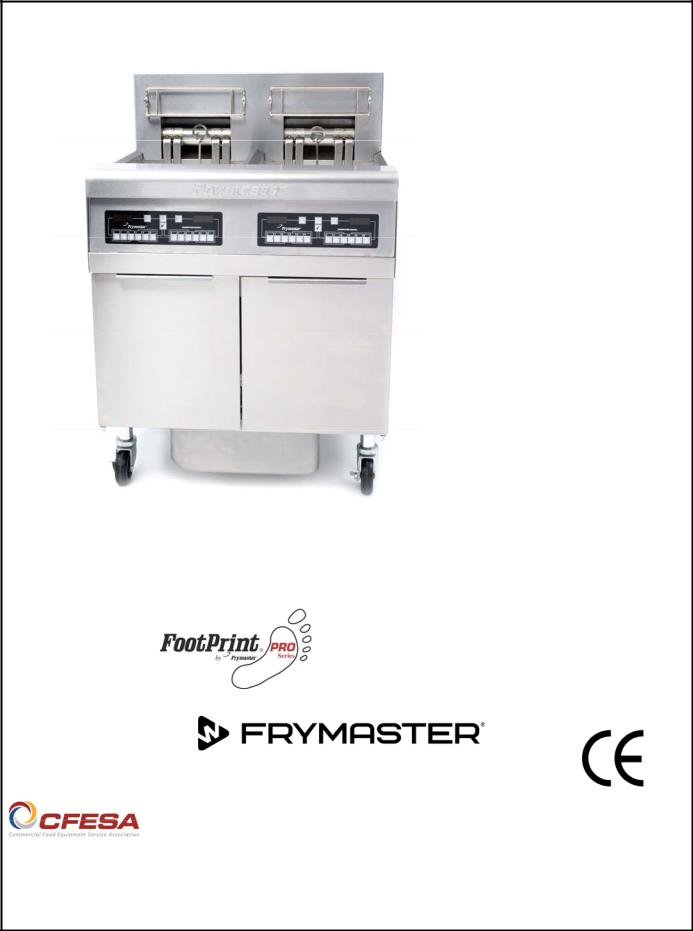
-HPRE80, FPRE80, XFPRE80, XRE, FPRE80 and RE80 Models
-YUM YSCFRE18, XYCFRE18 and XYSCFRE18 Models
Manual Parts & Service |
RE Production High E4 Electric RE80 (HPRE) |
|
|
|
|
Frymaster, a member of the Commercial Food Equipment Service Association, recommends using CFESA Certified Technicians.
|
24-Hour Service Hotline 1-800-551-8633 |
12/2017 |
|
|
|
www.frymaster.com |
E-mail: fryservice@welbilt.com |
*8196666* |
|

NOTICE
IF, DURING THE WARRANTY PERIOD, THE CUSTOMER USES A PART FOR THIS FRYMASTER FOOD SERVICE EQUIPMENT OTHER THAN AN UNMODIFIED NEW OR RECYCLED PART PURCHASED DIRECTLY FROM FRYMASTER DEAN, OR ANY OF ITS AUTHORIZED SERVICE CENTERS, AND/OR THE PART BEING USED IS MODIFIED FROM ITS ORIGINAL CONFIGURATION, THIS WARRANTY WILL BE VOID. FURTHER, FRYMASTER DEAN AND ITS AFFILIATES WILL NOT BE LIABLE FOR ANY CLAIMS, DAMAGES OR EXPENSES INCURRED BY THE CUSTOMER WHICH ARISE DIRECTLY OR INDIRECTLY, IN WHOLE OR IN PART, DUE TO THE INSTALLATION OF ANY MODIFIED PART AND/OR PART RECEIVED FROM AN UNAUTHORIZED SERVICE CENTER.
 DANGER
DANGER
Copper wire suitable for at least 167°F (75°C) must be used for power connections.
 DANGER
DANGER
The electrical power supply for this appliance must be the same as indicated on the rating and serial number plate located on the inside of the fryer door.
 DANGER
DANGER
This appliance must be connected to the voltage and phase as specified on the rating and serial number plate located on the inside of the fryer door.
 DANGER
DANGER
All wiring connections for this appliance must be made in accordance with the wiring diagrams furnished with the equipment. Wiring diagrams are located on the inside of the fryer door.
 DANGER
DANGER
Do not store or use gasoline or other flammable vapors and liquids in the vicinity of this or any other appliance.
 WARNING
WARNING
Do not attach accessories to this fryer unless fryer is secured from tipping. Personal injury may result.
 WARNING
WARNING
Frymaster fryers equipped with legs are for permanent installations. Fryers fitted with legs must be lifted during movement to avoid damage and possible bodily injury. For a moveable or portable installation, Frymaster optional equipment casters must be used.
Questions? Call 1-800-551-8633 or email at fryservice@welbilt.com.
 WARNING
WARNING
Do not use water jets to clean this equipment.
 WARNING
WARNING
This equipment is intended for indoor use only. Do not install or operate this equipment in outdoor areas.
i

 DANGER
DANGER
Adequate means must be provided to limit the movement of this appliance without depending on or transmitting stress to the electrical conduit. A restraint kit is provided with the fryer. If the restraint kit is missing contact your local Frymaster Factory Authorized Servicer (FAS) for part number 826-0900.
 DANGER
DANGER
Prior to movement, testing, maintenance and any repair on your Frymaster fryer, disconnect all electrical power from the fryer.
ELECTRICAL POWER SPECIFICATIONS
Three (3) Phase Requirements
|
|
|
WIRE |
MINIMUM SIZE |
AMPS PER LEG |
|||
kW |
VOLTAGE |
PHASE |
SERVICE |
AWG |
mm2 |
L1 |
L2 |
L3 |
17 |
208 |
3 |
3 |
4 |
16 |
48 |
48 |
48 |
17 |
240 |
3 |
3 |
6 |
16 |
41 |
41 |
41 |
17 |
480 |
3 |
3 |
8 |
16 |
21 |
21 |
21 |
17 |
220/380 |
3 |
4 |
8 |
16 |
26 |
26 |
26 |
17 |
240/415 |
3 |
4 |
8 |
16 |
24 |
24 |
24 |
17 |
230/400 |
3 |
4 |
8 |
16 |
25 |
25 |
25 |
21 |
208 |
3 |
3 |
4 |
25 |
58 |
58 |
58 |
21 |
240 |
3 |
3 |
4 |
25 |
51 |
51 |
51 |
21 |
480 |
3 |
3 |
8 |
16 |
25 |
25 |
25 |
21 |
220/380 |
3 |
4 |
6 |
16 |
32 |
32 |
32 |
21 |
240/415 |
3 |
4 |
8 |
16 |
29 |
29 |
29 |
21 |
230/400 |
3 |
4 |
8 |
16 |
30 |
30 |
30 |
ii

E4 SERIES HIGH PRODUCTION RE ELECTRIC FRYERS TABLE OF
CONTENTS
CAUTIONARY STATEMENTS........................................................................................................ |
i |
||
ELECTRICAL POWER SPECIFICATIONS................................................................................. |
ii |
||
CHAPTER 1: Service Procedures |
|
||
1.1 |
General |
.............................................................................................................................. |
1-1 |
1.2 |
Replacing .......................................................................................................a Controller |
1-1 |
|
1.3 |
Replacing ..........................................................................Component Box Components |
1-1 |
|
1.4 |
Replacing ..................................................................................a High-Limit Thermostat |
1-3 |
|
1.5 |
Replacing ........................................................................................a Temperature Probe |
1-3 |
|
1.6 |
Replacing ............................................................................................a Heating Element |
1-5 |
|
1.7 |
Replacing .............................................................................Contactor Box Components |
1-6 |
|
1.8 |
Replacing ............................................................................................................a Frypot |
1-7 |
|
1.9 |
Built-In ..................................................................Filtration System Service Procedures |
1-9 |
|
|
1.9.1 ............................................................... |
Filtration System Problem Resolution |
1-9 |
|
1.9.2 ................. |
Replacing the Filter Motor, Filter Pump and Related Components |
1-10 |
|
1.9.3 ............................................. |
Replacing the Filter Transformer or Filter Relay |
1-12 |
1.10 |
Basket Lift .......................................................................................Service Procedures |
1-12 |
|
1.11 |
Interface ....................................................................................Board Diagnostic Chart |
1-15 |
|
1.12 |
Probe Resistance ....................................................................................................Chart |
1-16 |
|
1.13 |
Wiring Diagrams ............................................................................................................. |
1-17 |
|
|
1.13.1 ........................................................ |
Basket Lift (480V/120V Control Supply) |
1-17 |
|
1.13.2 ................................................................................................. |
PBI Basket Lift |
1-18 |
|
1.13.3 ............................................................................ |
Standard Component Wiring |
1-18 |
|
1.13.4 ............................................................... |
KFC1 and CM4s Component Wiring |
1-19 |
|
1.13.5 .................................................................. |
Component Wiring – Single Phase |
1-20 |
|
1.13.6 ............................................................ |
Component Wiring – 480V Non - Filter |
1-21 |
|
1.13.7 ..................................................................... |
Component Wiring – Fast Ready |
1-22 |
|
1.13.8 .......................................................... |
Component Wiring – KFC India K3000 |
1-23 |
|
1.13.9 .............................................................. |
Component Wiring – KFC India Fast |
1-24 |
|
1.13.10 ................................................................... |
Contactor Box – Domestic 17 kW |
1-25 |
|
1.13.11 ................................................................... |
Contactor Box – Domestic 21 kW |
1-25 |
|
1.13.12 ....................................................... |
Contactor Box – Export 17kW and 21kW |
1-26 |
|
1.13.13 ......................................... |
Contactor Box – Chinese Export 17kW and 21kW |
1-27 |
|
1.13.14 ....................................................... |
Contactor Box – Export KFC India 17kW |
1-27 |
CHAPTER 2: Parts List |
|
||
2.1 |
Accessories........................................................................................................................ |
2-1 |
|
2.2 |
Cabinetry ........................................................................................................................... |
2-2 |
|
|
2.2.1 ........ |
Backs, Control Panel Frames, Doors, Sides, Tilt Housings and Top Caps |
2-2 |
|
2.2.2 ...................................................... |
Cabinet Bases, Braces and Associated Parts |
2-5 |
|
2.2.3 ....................................................... |
Basket Lift Assembly and Associated Parts |
2-7 |
2.3 |
Filtration ..........................................................................................System Components |
2-9 |
|
|
2.3.1 ............................................................................................................ |
Filter Pan |
2-9 |
|
2.3.1 ....................................................................................................... |
Filter Pump |
2-11 |
2.4 |
Drain System ..............................................................................................Components |
2-12 |
|
|
2.4.1 .................................................................. |
Drain Valves and Associated Parts |
2-12 |
|
2.4.2 .................................................................................... |
Drain System Plumbing |
2-14 |
iii

E4 SERIES HIGH PRODUCTION RE ELECTRIC FRYERS
TABLE OF CONTENTS (cont.)
2.5 |
Oil Return System Components ...................................................................................... |
2-15 |
|
|
2.5.1 |
Oil Disposal Wand ........................................................................................... |
2-15 |
|
2.5.2 |
KFC Over - the - Top Return ............................................................................... |
2-18 |
|
2.5.3 |
Drain Flush ....................................................................................................... |
2-19 |
2.6 |
Heating Elements ............................................................................................................ |
2-20 |
|
|
2.6.1 |
Element Assemblies and Hardware .................................................................. |
2-20 |
|
2.6.2 |
Element Tube Assembly .................................................................................. |
2-22 |
2.7 |
Frypots and Associated Parts .......................................................................................... |
2-23 |
|
2.8 |
Controllers ....................................................................................................................... |
2-24 |
|
2.9 |
Electronics and Electrical Components........................................................................... |
2-25 |
|
|
2.9.1 |
Component Boxes ............................................................................................ |
2-25 |
|
2.9.2 |
Contactor Boxes ............................................................................................... |
2-27 |
|
2.9.3 |
Fuse Boxes ....................................................................................................... |
2-29 |
|
2.9.4 |
Terminal Blocks ............................................................................................... |
2-30 |
|
2.9.5 |
Cord Sets .......................................................................................................... |
2-31 |
2.10 |
Wiring |
............................................................................................................................. |
2-31 |
|
2.10.1 |
Contactor Box Wiring Assemblies 6 - Pin (Left) & 9 - Pin (Right) Elements ..... |
2-31 |
|
2.10.2 ................... |
Component Box, Filter Pump and Basket Lift Wiring Harnesses |
2-32 |
2.11 |
Wiring ..........................................................................Connectors and Pin Connectors |
2-33 |
|
2.12 |
Fasteners.......................................................................................................................... |
2-34 |
|
iv

E4 SERIES HIGH PRODUCTION RE ELECTRIC FRYERS
CHAPTER 1: SERVICE PROCEDURES
1.1 General
Before performing any maintenance on your Frymaster fryer, disconnect the fryer from the electrical power supply.
When electrical wires are disconnected, it is recommended that they be marked in such a way as to facilitate re-assembly.
1.2 Replacing a Controller
1.Disconnect the fryer from the electrical power supply.
2.The controller bezel is held in place by tabs at the top and bottom. Slide the metal bezel up to disengage the lower tabs. Then slide the bezel down to disengage the upper tabs.
3.Remove the two screws from the upper corners of the control panel. The control panel is hinged at the bottom and swings open from the top.
4.Unplug the wiring harness from the connector on the back of the controller and disconnect the grounding wire from terminal adjacent to the connector. Remove the control panel assembly by lifting it from the hinged slots in the control panel frame.
5.Remove the controller from the control panel assembly and install the replacement controller. Reinstall the control panel assembly by reversing steps 1 and 2.
1.3 Replacing Component Box Components
1.Disconnect the fryer from the electrical power supply.
2.The controller bezel is held in place by tabs at the top and bottom. Slide the metal bezel up to disengage the lower tabs. Then slide the bezel down to disengage the upper tabs.
3.Remove the two screws from the upper corners of the control panel and allow the control panel to swing down.
4.Unplug the wiring harness from the 15-pin connector on the interface board and disconnect the grounding wire from terminal adjacent to the 15-pin connector on the back of the controller. Remove the control panel assembly by lifting it from the hinge slots in the control panel frame.
5.Disconnect the wiring from the component to be replaced, being sure to make a note of where each wire was connected.
6.Dismount the component to be replaced and install the new component, being sure that any required spacers, insulation, washers, etc. are in place.
1-1
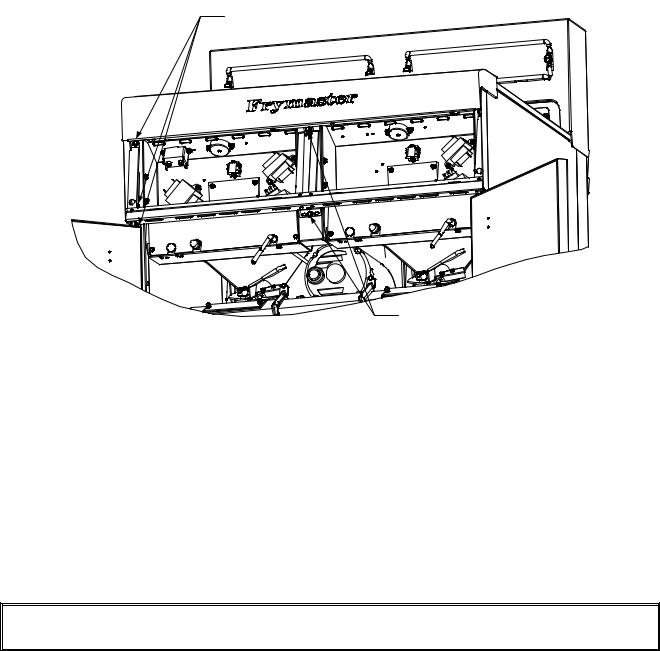
NOTE: If more room to work is required, the control panel frame assembly may be removed by removing the hex head screws that secure it to the fryer cabinet (see illustration below). If this option is chosen, all control panel assemblies must be removed per steps 1 and 2 above. The cover plate on the lower front of the component box may also be removed if desired. Removing the component box itself from the fryer is not recommended due to the difficulty involved in disconnecting and reconnecting the oil-return valve rods, which pass through openings in the component box.
Remove these three |
screws at each end. |
Remove these two screws |
from the center supports. |
Removing the Control Panel Frame and Top Cap Assembly |
7.Reconnect the wiring disconnected in Step 3, referring to your notes and the wiring diagrams on the fryer door to ensure that the connections are properly made. Also, verify that no other wiring was disconnected accidentally during the replacement process.
8.Reverse steps 1 through 4 to complete the replacement and return the fryer to service.
1.4 Replacing a High-Limit Thermostat
1.Remove the filter pan and lid from the unit. Drain the frypots into a Shortening Disposal Unit (SDU) or other appropriate metal container.
 DANGER
DANGER
DO NOT drain more than one full frypot or two split frypots into the SDU at one time.
2.Disconnect the fryer from the electrical power supply and reposition it to gain access to the rear of the fryer.
3.Remove the four screws from both the left and right sides of the lower back panel.
1-2
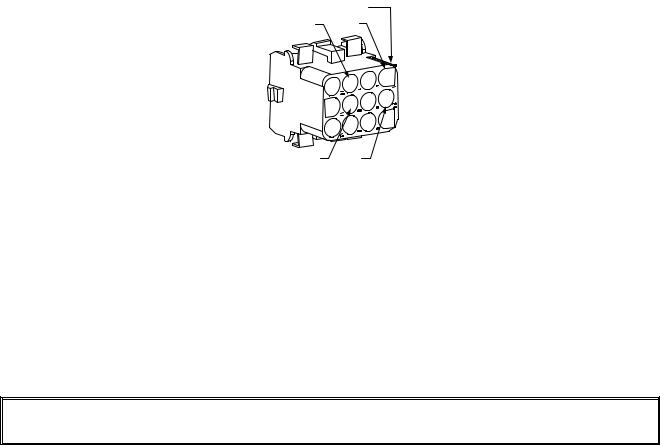
4.Locate the high-limit that is being replaced and follow the two-black wires to the 12-pin connector C-6. Note where the leads are connected prior to removing them from the connector. Unplug the 12-pin connector C-6 and using a pin-pusher push the pins of the high-limit out of the connector.
5.Using a wrench, carefully unscrew the high-limit thermostat to be replaced.
6.Apply Loctite™ PST 567 or equivalent sealant to the threads of the replacement and screw it securely into the frypot.
7.Insert the leads into the 12-pin connector C-6 (see illustration below). For full-vat units or the left half of a dual-vat unit (as viewed from the rear of the fryer) the leads go into positions 1 and 2 of the connector. For the right half of a dual-vat unit (as viewed from the rear of the fryer), the leads go into positions 7 and 8. In either case, polarity does not matter.
8.Reconnect the 12-pin connecting plug C-6. Use wire ties to secure any loose wires.
9.Reinstall the back panels reposition the fryer under the exhaust hood, and reconnect it to the electrical power supply to return the fryer to service.
1.5 Replacing a Temperature Probe
1.Remove the filter pan and lid from the unit. Drain the frypots into a Shortening Disposal Unit (SDU) or other appropriate metal container.
 DANGER
DANGER
DO NOT drain more than one full frypot or two split frypots into the SDU at one time.
2.Disconnect the fryer from the electrical power supply and reposition it to gain access to the rear of the fryer.
3.Remove the four screws from both sides of the lower back panel. Then remove the two screws on both the left and right sides of the back of the tilt housing. Lift the tilt housing straight up to remove from the fryer.
4.Locate the red and white wires of the temperature probe to be replaced. Note where the leads are connected prior to removing them from the connector. Unplug the 12-pin connector C-6 and using a pin-pusher push the pins of the temperature probe out of the connector.
1-3
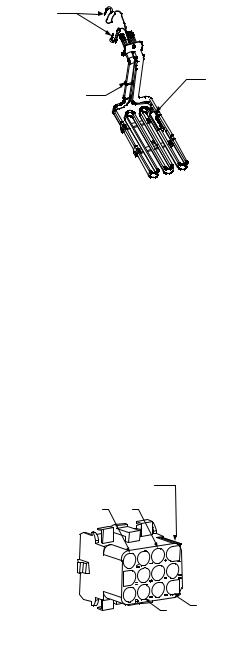
5.Raise the element and remove the securing probe bracket and metal tie wraps that secure the probe to the element (see illustration below).
6.Gently pull on the temperature probe and grommet, pulling the wires up the rear of the fryer and through the element tube assembly.
7.Insert the replacement temperature probe (wires first) into the tube assembly ensuring that the grommet is in place. Secure the probe to the elements using the bracket which was removed in Step 5 and the metal tie wraps which were included in the replacement kit.
8.Route the probe wires out of the tube assembly following the element wires down the back of the fryer through the Heyco bushings to the 12-pin connector C-6. Secure the wires to the sheathing with wire ties.
9.Insert the temperature probe leads into the 12-pin connector C-6 (see illustration below). For full-vat units or the right half of a dual-vat unit (as viewed from the rear of the fryer) the red lead goes into position 3 and the white lead into position 4 of the connector. For the left half of a dual-vat unit (as viewed from the rear of the fryer), the red lead goes into position 9 and the white lead into position 10. NOTE: Right and left refer to the fryer as viewed from the rear.
10.Secure any loose wires with wire ties making sure that the lead wires will not interfere with the movement of the springs. Rotate the elements up and down making sure that movement is not restricted and that the wires are not pinched.
11.Reinstall the tilt housing and back panels, reposition the fryer under the exhaust hood, and reconnect it to the electrical power supply to return the fryer to service.
1.6Replacing a Heating Element
1. Perform steps 1-3 of section 1.5, Replacing a Temperature Probe.
1-4
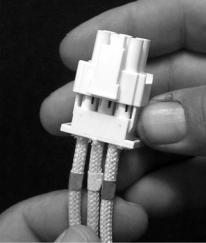
2.On dual-vat fryers, and on full-vat fryers where the temperature probe is attached to the element being replaced, disconnect the wire harness containing the probe wiring. Using a pin pusher, disconnect the probe wires from the 12-pin connector C-6.
3.Remove screws holding element wiring cover in place and remove cover.
4.In the rear of the fryer directly behind the frypot disconnect the 6-pin connector for the left element (as viewed from the front of the fryer) or the 9-pin connector for the right element. Press in on the tabs on each side of the connector while pulling outward on the free end to extend the connector and release the element leads (see photo below). Pull the leads out of the connector and out of the wire sleeving.
5.Raise the element to the full up position and support the elements.
6.Remove the hex head screws and nuts that secure the element to the tube assembly and pull the element out of the frypot. NOTE: Full-vat elements consist of two dual-vat elements clamped together. For full-vat units, remove the element clamps before removing the nuts and screws that secure the element to the tube assembly.
7.If applicable, recover the probe bracket and probe from the element being replaced and install them on the replacement element. Install the replacement element in the frypot, securing it with the nuts and screws removed in Step 5 to the tube assembly. Ensure the gasket is between the tube and element assembly.
8.Route the element leads through the element tube assembly and into the wire sleeving to prevent chafing. Ensure that the wire sleeving is routed back through the Heyco bushing keeping it clear from the lift springs. Also ensure that the wire sleeving extends into the tube assembly to prevent the edge of the tube assembly from chafing the wires. Press the pins into the connector in accordance with the diagram on the following page, and then close the connector to lock the leads in place. NOTE: It is critical that the wires be routed through the sleeving to prevent chafing.
1-5
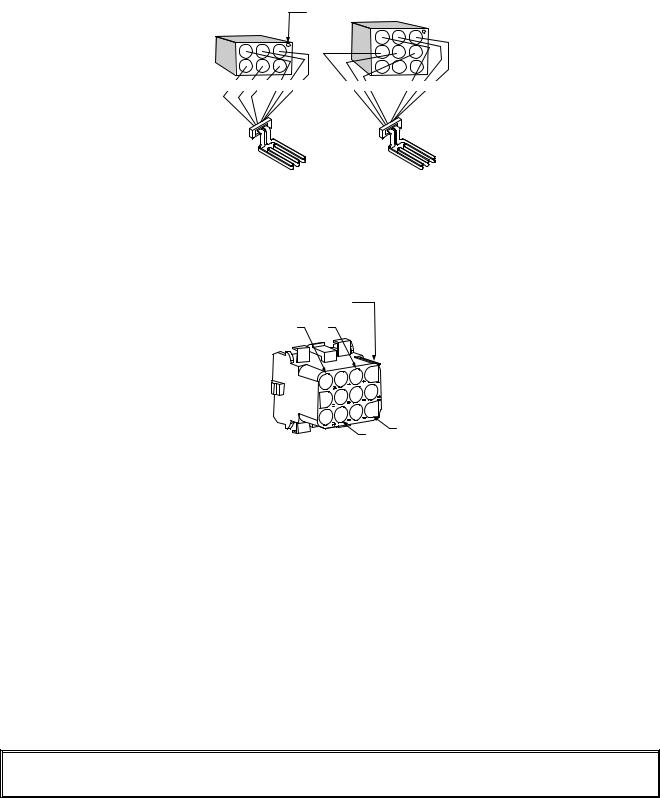
|
|
|
|
|
Index Marker marks |
|
|
|
||
|
|
|
|
|
Position 1 |
|
|
|
|
|
|
|
|
|
|
|
|
3 |
2 |
1 |
|
|
3 |
2 |
1 |
|
|
|
6 |
5 |
4 |
|
|
6 |
5 |
4 |
|
|
|
9 |
8 |
7 |
|
6L |
5L |
4L |
3L 2L |
1L |
6 |
5 |
4R |
3R |
2 |
1R |
|
|
|
|
|
R |
R |
|
|
R |
|
9.Reconnect the element connector ensuring that the latches lock.
10.Insert the temperature probe leads into the 12-pin wiring harness connector C-6 (see illustration below). For full-vat units or the right half of a dual-vat unit, the red lead goes into position 3 and the white into position 4. For the left half of a dual-vat unit, the red lead goes into position 9 and the white into position 10. NOTE: Right and left refer to the fryer as viewed from the rear.
10.Reconnect the 12-pin connector C-6 of the wiring harness disconnected in Step 2.
disconnected in Step 2.
11.Lower the element down onto the basket rack.
12.Reinstall the tilt housing, upper cover and back panels, reposition the fryer under the exhaust hood, and reconnect it to the electrical power supply.
1.7Replacing Contactor Box Components
1.If replacing a contactor box component above the built-in filter system, remove the filter pan and lid from the unit. Drain the frypots into a Shortening Disposal Unit (SDU) or other appropriate metal container. If replacing a contactor box component in a non-filter unit or a frypot that’s not over the filter pan, drain the frypot above the box into a Shortening Disposal Unit (SDU) or other appropriate metal container.
 DANGER
DANGER
DO NOT drain more than one full frypot or two split frypots into the SDU at one time.
2.Disconnect the fryer from the electrical power supply.
3.Remove the two screws securing the cover of the contactor box. The contactor boxes above the filter pan are accessed by sliding under the fryer. They are located to the left and right above the
1-6

guide rails (see photo below). The contactor boxes of non-filter units or frypots not over the filter pan are accessed by opening the fryer door directly under the affected frypot.
4.The contactors and relays are held on by threaded pin studs so that only removal of the nut is required to replace the component.
5.After performing necessary service, reverse steps 1-4 to return the fryer to operation.
1.8 Replacing a Frypot
1.Drain the frypot into the filter pan or, if replacing a frypot over the filter system, into a Shortening Disposal Unit (SDU) or other appropriate metal container. If replacing a frypot over the filter system, remove the filter pan and lid from the unit.
 DANGER
DANGER
DO NOT drain more than one full frypot or two split frypots into the SDU at one time.
2.Disconnect the fryer from the electrical power supply and reposition it to gain access to both the front and rear.
3.Slide the metal bezel up to release the bottom tabs, then slide the bezel down to disengage the upper tabs.
4.Remove the two screws from the upper corners of the control panels and allow them to swing down (see illustration and photo on page 1-1).
5.Unplug the wiring harnesses and ground wires from the backs of the controllers. Remove the controllers by lifting them from the hinge slots in the control panel frame.
6.Remove the tilt housing and back panels from the fryer. The tilt housing must be removed first in order to remove the upper back panel.
7.To remove the tilt housing remove the hex head screws from the rear edge of the housing. The housing can be lifted straight up and off the fryer.
8.Remove the control panel by removing the screw in the center and the nuts on both sides.
9.Loosen the component boxes by removing the screws, which secure them in the cabinet.
10.Dismount the top cap by removing the nuts at each end that secure it to the cabinetry.
11.Remove the hex head screw that secures the front of the frypot to the cabinet cross brace.
12.Remove the top-connecting strip that covers the joint with the adjacent frypot.
13.Unscrew the Teflon vent/vacuum-breaker tube fitting, unscrew the nut located on the front of each section of drain tube, and remove the tube assembly from the fryer.
1-7
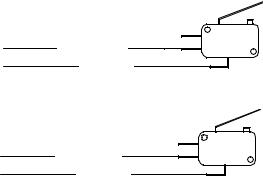
14.Remove the covers from the drain safety switch(es) and disconnect the switch wiring at the switch(es).
15.At the rear of the fryer, unplug the 12-pin connector C-6 and, using a pin pusher, disconnect the high-limit thermostat leads.
16.Disconnect the oil return flexline(s) at the frypot end(s).
17.Raise the elements to the “up” position and disconnect the element springs.
18.Remove the machine screws and nuts that secure the element tube assembly to the frypot. Carefully lift the element assembly from the frypot and secure it to the cross brace on the rear of the fryer with wire ties or tape.
19.Carefully lift the frypot from the fryer and place it upside down on a stable work surface.
20.Recover the drain valve(s), oil return flexline connection fitting(s), and high-limit thermostat(s) from the frypot. Clean threads and apply Loctite™ PST 567 or equivalent sealant to the threads of the recovered parts and install them in the replacement frypot.
21.Carefully lower the replacement frypot into the fryer. Reinstall the hex head screw removed in step 7 to attach the frypot to the fryer.
22.Position the element tube assembly in the frypot and reinstall the machine screws and nuts removed in step 14.
23.Reconnect the oil return flexlines to the frypot, and replace aluminum tape, if necessary, to secure heater strips to the flexlines.
24.Insert the high-limit thermostat leads disconnected in step 13 (see illustration on page 1-3 for pin positions).
25.Reconnect the drain safety switch wiring to the switch(es) in accordance with the diagram below then reinstall the switch covers.
RIGHT
ORANGE Pin 15 J4 DRAIN SAFETY SWITCH
BLUE Pin 1 C6
|
LEFT |
ORANGE Pin 7 J4 |
DRAIN SAFETY SWITCH |
(DUAL-VAT ONLY) |
BLUE Pin 7 C6
26.Reinstall the drain tube assembly.
27.Reinstall the top connecting strips, top cap, control panel, component box, tilt housing and back panels.
28.Reinstall controllers in the control panel frame and reconnect the wiring harnesses and ground wires.
29.Reposition the fryer under the exhaust hood and reconnect it to the electrical power supply.
1-8
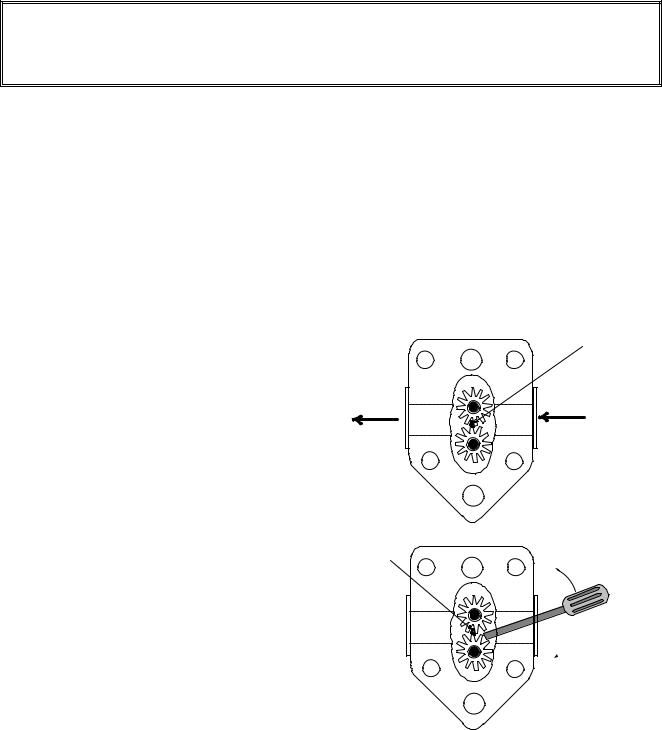
1.9 Built-in Filtration System Service Procedures 1.9.1 Filtration System Problem Resolution
One of the most common causes of filtration problems is placing the filter paper on the bottom of the filter pan rather than over the filter screen.
 CAUTION
CAUTION
Ensure that filter screen is in place prior to filter paper placement and filter pump operation. Improper screen placement is the primary cause of filtration system malfunction.
Whenever the complaint is “the pump is running, but no oil is being filtered,” check the installation of the filter paper, and ensure that the correct size is being used. While you are checking the filter paper, verify that the O-rings on the pick-up tube of the filter pan are in good condition. Missing or worn O-rings allow the pump to take in air and decrease its efficiency.
If the pump motor overheats, the thermal overload will trip and the motor will not start until it is reset. If the pump motor does not start, press the red reset switch (button) located on the rear of the motor at the front of the fryer.
If the pump starts after resetting the thermal overload switch, then something is causing the motor to overheat. A major cause of overheating is when several frypots are filtered sequentially, overheating the pump and motor. Allow the pump motor to cool at least 30 minutes before resuming operation. Pump overheating can be caused by:
Solidified shortening in the pan or filter lines, or
Attempting to filter unheated oil (cold oil is more viscous, overloading the pump motor and causing it to overheat).
If the motor runs but the pump does not return oil, there is a blockage in the pump. Incorrectly sized or installed paper/pads will allow food particles and sediment to pass
through the filter pan and into the pump. Sediment Particle When sediment enters the pump, the gears
bind, causing the motor to overload, again tripping the thermal overload. Shortening that has solidified in the pump will also cause it to seize, with the same result.
A pump seized by debris or hard shortening can usually be freed by manually moving the gears with a screwdriver or other instrument.
Sediment Particle
Oil Flow
Up for reverse
 Down for forward
Down for forward
1-9
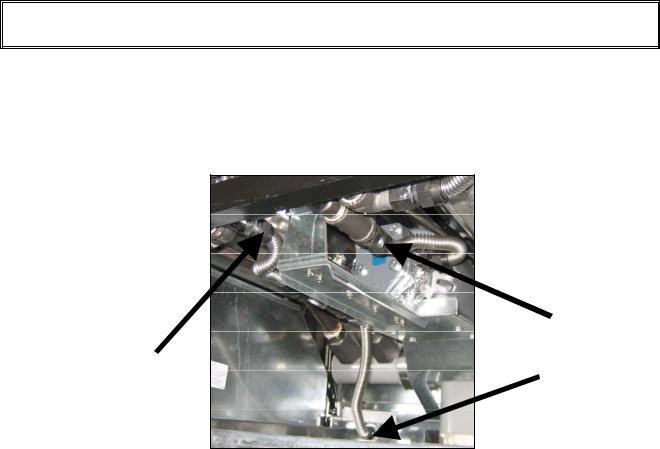
Disconnect power to the filter system, remove the input plumbing from the pump, and use a screwdriver to manually turn the gears.
●Turning the pump gears in reverse will release a hard particle.
●Turning the pump gears forward will push softer objects and solid shortening through the pump and allow free movement of the gears.
Incorrectly sized or installed paper/pads will also allow food particles and sediment to pass through and clog the suction tube on the bottom of the filter pan. Particles large enough to block the suction tube may indicate that the crumb tray is not being used. Pan blockage can also occur if shortening is left in the pan and allowed to solidify. Blockage removal can be accomplished by forcing the item out with an auger or drain snake. Compressed air or other pressurized gases should not be used to force out the blockage.
1.9.2 Replacing the Filter Motor, Filter Pump, and Related Components
1. Drain the frypots into a Shortening Disposal Unit (SDU) or other appropriate metal container.
 DANGER
DANGER
DO NOT drain more than one full frypot or two split frypots into the SDU at one time.
2.Disconnect the fryer from the electrical power supply and reposition it to gain access to both the front and rear.
3.Disconnect the two flexlines running to the oil-return manifold at the rear of the fryer as well as the pump suction flexline at the end of the filter pan connection (see photo below).
Disconnect flexlines indicated by the arrows.
4.Remove the cover plate from the front of the motor and disconnect the motor wires.
5.Unplug the pump motor assembly 6-pin connector C-2 and, using a pin pusher, disconnect the vent vacuum-breaker solenoid (pins 2 and 5) that is attached to the oil return manifold.
1-10
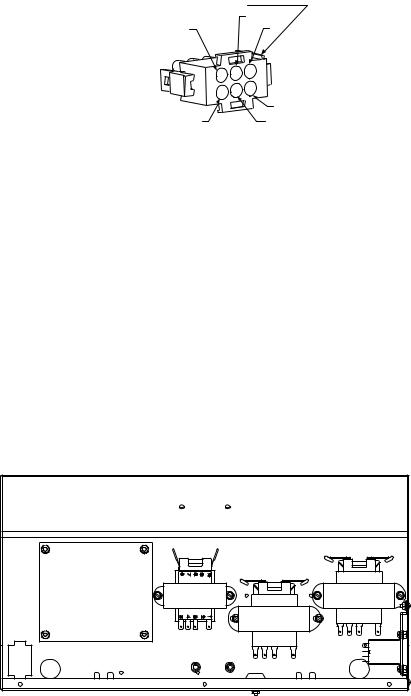
6.When complete, reverse steps to reinstall the bridge. NOTE: The black motor wires go on the top terminal, the white on the bottom. The pump solenoid valve wires go in positions 1 and 4 of the 6-pin connector C-2; the vent vacuum-breaker solenoid valve wires go in positions 2 and 5; the red/black heater tape wires go into position 3 and the violet/white wires go into position 6 (see illustration on the following page).
7.Disconnect any heater tape wiring from connectors and remove heater tape. Motor and pump can be separated and removed individually or as one unit.
8.Reconnect the unit to the electrical power supply, and verify that the pump is functioning correctly (i.e., when a filter handle is placed in the ON position, the motor should start and there should be strong suction at the intake fitting and outflow at the rear flush port.)
9.When proper operation has been verified, reinstall the back panels and the filter pan and lid.
10.Reposition the fryer under the exhaust hood and reconnect it to the electrical power supply to return the fryer to service.
1.9.3 Replacing the Filter Transformer or Filter Relay
Disconnect the fryer from the electrical power supply. Remove the left controller from the fryer to expose the interior of the left component box. The filter transformer and relay are behind the controller on a single fryer or just right of the filter in a bank of two or more. The filter transformer and relay are located as shown in the illustration below. .
RE Control Box
1-11
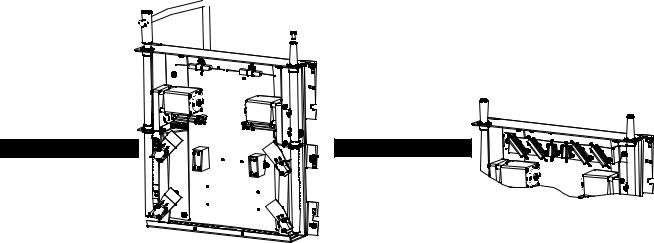
1.10 Basket Lift Service Procedures
High Production RE Series electric fryers may be equipped with automatic basket lifts. Basket lifts always come in pairs, although each operates independently.
A modular basket lift (illustrated on the following page) is a self-contained sub-assembly consisting of a pair of toothed rods which support removable basket lift arms, a pair of reversibledrive gear motors, and four microswitches. The gear motors engage the teeth of the rods, moving them up or down depending upon the motors’ direction of rotation. The microswitches at the upper and lower limits of movement stop the motors when the basket is in the full up or full down position. Timing circuitry in the controller initiates and stops basket lift operation depending upon the variables programmed by the operator. When the product button is pressed, the timing circuitry activates a coil in the basket lift relay to supply power to the lower microswitch. The microswitches stop the motor at the lift’s upper and lower travel limits and reverse the direction of current flow thus reversing the motor direction.
When the product button is pushed on the computer/controller, current flows through a coil in the basket lift relay, causing the lower circuit to be activated. The basket lift lowers, closing the normally open upper-micro-switch. When the downward-moving rod opens the lower normally closed microswitch, the power to the motor ceases to flow. When the computer/controller times out, the current to the relay coil is cut, allowing the upper circuit to be activated. The basket lift then raises and re-closes the lower microswitch. When the basket lift rod clears the upper microswitch, the microswitch reopens, power to the circuit is cut, and the motor stops. Pushing the product button restarts the cycle.
Problems with the basket lift can be grouped into three categories:
●Binding/jamming problems
●Motor and gear problems
●Electronic problems
100-120V Configuration |
208-250V Configuration |
1-12
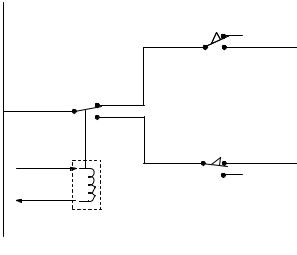
BINDING/JAMMING PROBLEMS
Noisy, jerky or erratic movement of the lifts is usually due to lack of lubrication of the rods and their bushings. Apply a light coat of Lubriplate® or similar lightweight white grease to the rod and bushings to correct the problem.
With the modular basket lift, another possible cause of binding is improper positioning of the motor, which prevents the gear from correctly engaging the teeth in the rod. To correct the problem, loosen the screws that hold the motor in place and move it forward or backward until the rod has just enough slack to be rotated slightly.
MOTOR AND GEAR PROBLEMS
With the modular basket lift, the most likely problem to be encountered in this category is erratic motion of the lift due to a worn drive gear. Failure to keep the lift rod and bushings properly lubricated will cause unnecessary wear of the gear. The problem is corrected by replacing the worn gear.
If the lift cycles correctly but fails to remain in the up position (i.e., goes up, but then slowly settles back down into the frypot), the problem is a failed motor brake. A failed motor brake cannot be repaired and requires replacement of the motor itself.
If power is reaching the motor but the motor fails to run, the motor is burned out and must be replaced.
ELECTRONIC PROBLEMS
Within this category are problems associated with the relays, microswitches, capacitors, resistors, interface board, wiring, and controls. The most common problem in this category is a lift that continuously travels up and down. This is usually caused by a microswitch that is out of adjustment. Troubleshooting the electronics of a modular basket lift is simply a process of verifying current flow through the individual components up to and including the motor. Using a multimeter set to the 250 VAC range, check the connections on both sides of the component for the presence of the applied line voltage. The schematic below and the wiring diagram on page 1-16 can identify the components and wiring connection points.
1-13 |

1.11 Interface Board Diagnostic Chart
The following diagram and charts provide ten quick system checks that can be performed using only a multimeter.
|
|
|
|
|
|
|
|
|
|
|
|
|
|
|
|
|
|
|
|
|
|
|
|
|
|
|
|
|
|
|
|
|
|
|
|
|
|
|
|
|
|
|
|
|
|
|
|
|
|
|
|
|
|
|
|
|
|
|
|
|
|
|
|
|
|
|
|
|
|
|
|
|
|
|
|
|
|
|
|
|
|
|
|
|
|
|
|
|
|
|
|
|
|
|
|
|
|
|
|
|
|
|
|
|
|
|
|
|
|
|
|
|
|
|
|
|
|
|
|
|
|
|
|
|
|
|
|
|
|
|
|
|
|
|
|
|
Diagnostic LED Legend |
|
|
|
|
|
|
|
|
|
|
|
|
|
|
|
|
|
|
|
|
|
CMP |
indicates power from 12V transformer |
|
|
|
|
|
|
|
|
|
|
|
|
|
|
|
|
|
|
|
|
|
24 |
indicates power from 24V transformer |
|
|
|
|
|
|
|
|
|
|
|
|
|
|
|
|
|
|
|
|
|
HI |
(RH) indicates output (closed) from right latch |
|
|
|
|
|
|
|
|
|
|
|
|
|
|
|
|
|
|
|
|
|
|
relay |
|
|
|
|
|
|
|
|
|
|
|
|
|
|
|
|
|
|
|
|
|
HI |
(LH) indicates output (closed) from left latch relay |
|
|
|
|
|
|
|
|
|
|
|
|
|
|
|
|
|
|
|
|
|
HT |
(RH) indicates output from right heat relay |
|
|
|
|
|
|
|
|
|
|
|
|
|
|
|
|
|
|
|
|
|
HT |
(LH) indicates output from left heat relay |
|
|
|
|
|
|
|
|
|
|
|
|
|
|
|
|
|
|
|
|
|
AL |
(RH) indicates output (open) from right latch relay |
|
|
|
|
|
|
|
|
|
|
|
|
|
|
|
|
|
|
|
|
|
||
|
|
|
|
|
|
|
|
|
|
|
|
|
|
|
|
|
|
|
|
|
AL |
(LH) indicates output (open) from left latch relay |
|
|
|
|
|
|
|
|
|
|
|
|
|
|
|
|
|
|
|
|
|
||
|
|
|
|
|
|
|
|
|
|
|
|
|
|
|
|
|
|
|
|
|
|
|
|
|
|
|
|
|
|
|
|
|
|
|
|
|
|
|
|
|
|
|
|
|
|
|
|
|
|
|
|
|
|
|
|
|
|
|
|
|
|
|
|
|
|
|
|
|
|
|
|
|
|
|
|
|
|
|
|
|
|
|
|
|
|
|
|
|
|
|
|
|
|
|
|
|
|
|
|
|
|
|
|
|
|
|
|
|
|
|
|
|
|
|
|
|
|
|
|
|
|
|
|
|
|
|
|
|
|
|
|
|
|
|
|
|
|
|
|
|
|
|
|
|
|
|
|
|
|
|
|
|
|
|
|
|
|
|
|
|
|
|
|
|
|
|
|
|
|
|
|
|
|
|
|
|
|
|
|
|
|
|
|
 PN 106-6664
PN 106-6664
NOTE – When testing the test points on J1
and J2 test use the illustration above disregarding any silk-screened numbers on the board depicting the location of Pin 1. Pin 1 is located in the bottom right corner of both J1 and J2. These test points are ONLY for RE Series boards with J1 and J2 plugs on the front of the board.
Meter Setting |
Test |
Pin |
Pin |
Results |
12 VAC Power |
50 VAC Scale |
3 of J2 |
1 of J2 |
12-16 VAC |
24 VAC Power |
50 VAC Scale |
2 of J2 |
Chassis |
24-30 VAC |
*Probe Resistance (RH) |
R X 1000 OHMS |
11 of J2 |
10 of J2 |
See Chart |
*Probe Resistance (LH) |
R X 1000 OHMS |
1 of J1 |
2 of J1 |
See Chart |
High-Limit Continuity (RH) |
R X 1 OHMS |
9 of J2 |
6 of J2 |
0 - OHMS |
High-Limit Continuity (LH) |
R X 1 OHMS |
6 of J1 |
9 of J1 |
0 - OHMS |
Latch Contactor Coil (RH) |
R X 1 OHMS |
8 of J2 |
Chassis |
3-10 OHMS |
Latch Contactor Coil (LH) |
R X 1 OHMS |
5 of J1 |
Chassis |
3-10 OHMS |
Heat Contactor Coil (RH) |
R X 1 OHMS |
7 of J2 |
Chassis |
11-15 OHMS |
Heat Contactor Coil (LH) |
R X 1 OHMS |
4 of J1 |
Chassis |
11-15 OHMS |
* Disconnect 15-Pin harness from the computer/controller before testing the probe circuit.
1-14
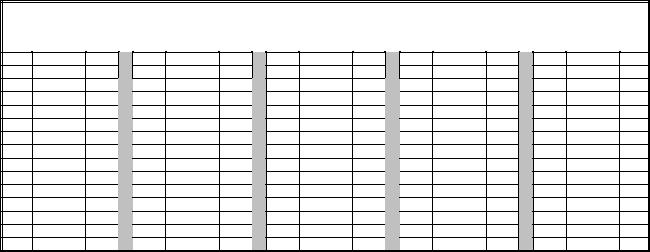
1.12 Probe Resistance Chart
Probe Resistance Chart
For use with fryers manufactured with Minco Thermistor probes only.
F |
OHMS |
C |
F |
OHMS |
C |
F |
OHMS |
C |
F |
OHMS |
C |
F |
OHMS |
C |
60 |
1059 |
16 |
130 |
1204 |
54 |
200 |
1350 |
93 |
270 |
1493 |
132 |
340 |
1634 |
171 |
65 |
1070 |
18 |
135 |
1216 |
57 |
205 |
1361 |
96 |
275 |
1503 |
135 |
345 |
1644 |
174 |
70 |
1080 |
21 |
140 |
1226 |
60 |
210 |
1371 |
99 |
280 |
1514 |
138 |
350 |
1654 |
177 |
75 |
1091 |
24 |
145 |
1237 |
63 |
215 |
1381 |
102 |
285 |
1524 |
141 |
355 |
1664 |
179 |
80 |
1101 |
27 |
150 |
1247 |
66 |
220 |
1391 |
104 |
290 |
1534 |
143 |
360 |
1674 |
182 |
85 |
1112 |
29 |
155 |
1258 |
68 |
225 |
1402 |
107 |
295 |
1544 |
146 |
365 |
1684 |
185 |
90 |
1122 |
32 |
160 |
1268 |
71 |
230 |
1412 |
110 |
300 |
1554 |
149 |
370 |
1694 |
188 |
95 |
1133 |
35 |
165 |
1278 |
74 |
235 |
1422 |
113 |
305 |
1564 |
152 |
375 |
1704 |
191 |
100 |
1143 |
38 |
170 |
1289 |
77 |
240 |
1432 |
116 |
310 |
1574 |
154 |
380 |
1714 |
193 |
105 |
1154 |
41 |
175 |
1299 |
79 |
245 |
1442 |
118 |
315 |
1584 |
157 |
385 |
1724 |
196 |
110 |
1164 |
43 |
180 |
1309 |
82 |
250 |
1453 |
121 |
320 |
1594 |
160 |
390 |
1734 |
199 |
115 |
1174 |
46 |
185 |
1320 |
85 |
255 |
1463 |
124 |
325 |
1604 |
163 |
395 |
1744 |
202 |
120 |
1185 |
49 |
190 |
1330 |
88 |
260 |
1473 |
127 |
330 |
1614 |
166 |
400 |
1754 |
204 |
125 |
1195 |
52 |
195 |
1340 |
91 |
265 |
1483 |
129 |
335 |
1624 |
168 |
405 |
1764 |
207 |
1-15
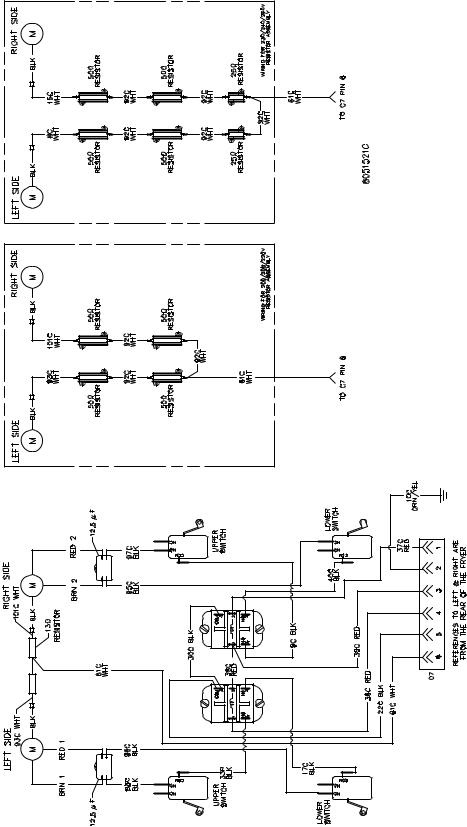
1.13 Wiring Diagrams
1.13.1 Basket Lift
1-16
